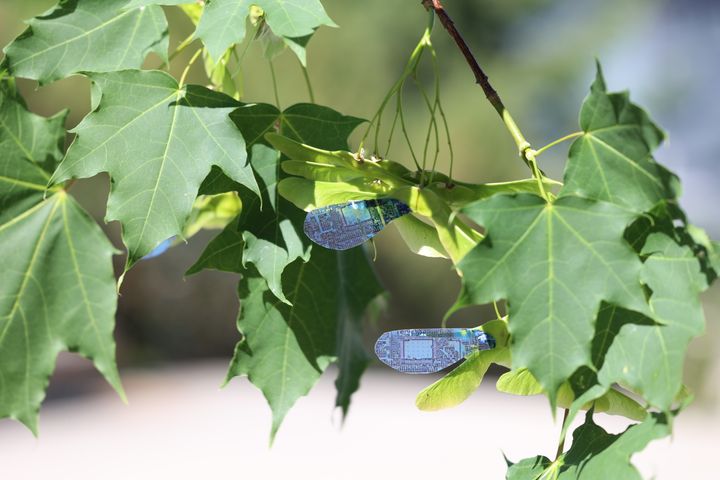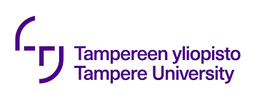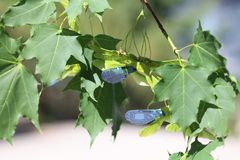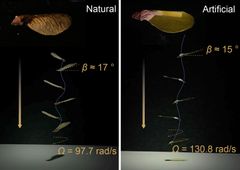Light-controlled artificial maple seeds could monitor the environment even in hard-to-reach locations
Researchers from Tampere University, Finland, and the University of Pittsburgh, USA, have developed a tiny robot replicating the aerial dance of falling maple seeds. In the future, this robot could be used for real-time environmental monitoring or delivery of small samples even in inaccessible terrain such as deserts, mountains or cliffs, or the open sea. This technology could be a game changer for fields such as search-and-rescue, endangered species studies, or infrastructure monitoring.

At Tampere University, Professor Hao Zeng and Doctoral Researcher Jianfeng Yang work at the interface between physics, soft mechanics, and material engineering in their Light Robots research group. They have drawn inspiration from nature to design polymeric gliding structures that can be controlled using light.
Now, Zeng and Yang, with Professor M. Ravi Shankar, from the University of Pittsburgh Swanson School of Engineering utilized a light-activated smart material to control the gliding mode of an artificial maple seed. In nature, maple disperse to new growth sites with the help of flying wings in their samara, or dry fruit. The wings help the seed to rotate as it falls, allowing it to glide in a gentle breeze. The configuration of these wings defines their glide path.
According to the researchers, the artificial maple seed can be actively controlled using light, where its dispersal in the wind can be actively tuned to achieve a range of gliding trajectories. In the future, it can also be equipped with various microsensors for environmental monitoring or be used to deliver, for example, small samples of soil.
Hi-tec robot beats natural seed in adaptability
The researchers were inspired by the variety of gliding seeds of Finnish trees, each exhibiting a unique and mesmerizing flight pattern. Their fundamental question was whether the structure of these seeds could be recreated using artificial materials to achieve a similar airborne elegance controlled by light.
“The tiny light-controlled robots are designed to be released into the atmosphere, utilizing passive flight to disperse widely through interactions with surrounding airflows. Equipped with GPS and various sensors, they can provide real-time monitoring of local environmental indicators like pH levels and heavy metal concentrations” explains Yang.
Inspired by natural maple samara, the team created azobenzene-based light-deformable liquid crystal elastomer that achieves reversible photochemical deformation to finely tune the aerodynamic properties.
“The artificial maple seeds outperform their natural counterparts in adjustable terminal velocity, rotation rate, and hovering positions, enhancing wind-assisted long-distance travel through self-rotation”, says Zeng.
In the beginning of 2023 Zeng and Yang released their first, dandelion seed like mini robot within the project Flying Aero-robots based on Light Responsive Materials Assembly – FAIRY. The project, funded by the Research Council of Finland, started in September 2021, and will continue until August 2026.
“Whether it is seeds or bacteria or insects, nature provides them with clever templates to move, feed and reproduce. Often this comes via a simple, but remarkably functional, mechanical design,” Shankar explains.
“Thanks to advances in materials that are photosensitive, we are able to dictate mechanical behavior at almost the molecular level. We now have the potential to create micro robots, drones, and probes that can not only reach inaccessible areas but also relay critical information to the user. This could be a game changer for fields such as search-and-rescue, endangered or invasive species studies, or infrastructure monitoring,” he adds.
The article "Photochemical Responsive Polymer Films Enable Tunable Gliding Flight" by Jianfeng Yang, M. Ravi Shankar, and Hao Zeng was published in Nature Communications on 1 June, 2024.
Avainsanat
Yhteyshenkilöt
Dr. Hao Zeng
hao.zeng@tuni.fi
Kuvat
Tampere University in brief
Tampere University brings together research and education in technology, health and society. Our collaboration with our partners is built on our strengths, unique combinations of scientific disciplines and applied expertise. We are working together to build a sustainable world. We develop solutions to tackle climate change, protect the natural environment and improve the well-being and sustainability of societies. There are 22,000 students and over 4,000 staff members at Tampere University. www.tuni.fi/en
Tilaa tiedotteet sähköpostiisi
Haluatko tietää asioista ensimmäisten joukossa? Kun tilaat tiedotteemme, saat ne sähköpostiisi välittömästi julkaisuhetkellä. Tilauksen voit halutessasi perua milloin tahansa.
Lue lisää julkaisijalta Tampereen yliopisto
Keinotekoinen, valo-ohjattava vaahteran siemen voisi kerätä ympäristödataa hankalistakin paikoista27.6.2024 09:00:00 EEST | Tiedote
Tampereen yliopiston ja Pittsburghin yliopiston tutkijat ovat kehittäneet minirobotin, joka jäljittelee vaahteran siementen tanssia ilmavirtausten mukana. Robotti voisi tulevaisuudessa havainnoida reaaliaikaisesti ympäristöä tai kuljettaa pieniä näytteitä haastavissakin olosuhteissa, kuten aavikoilla, vuoristoissa, jyrkänteillä ja avomerellä. Teknologia voisi mullistaa muun muassa etsintäpalvelut, uhanalaisten lajien tutkimuksen sekä infrastruktuurien valvonnan.
Muistisairaiden ympärivuorokautiseen hoitoon pääsyssä ja hoidon laadussa näkyy hoivaköyhyyden merkkejä26.6.2024 13:25:00 EEST | Tiedote
Tuoreessa tutkimuksessa tarkasteltiin hoivakodeissa asuvien muistisairaiden henkilöiden kohtaamattomia hoidontarpeita läheisten näkökulmasta. Tulosten perusteella muistisairaan hoitoon pääseminen saattoi edellyttää paitsi mittavia hoidontarpeita ja avointa paikkaa, myös todentuneita riskejä. Lisäksi hoitopaikan saaminen ei kaikkien kohdalla johtanut tarpeita vastaavaan hoitoon.
Lupaavan keliakialääkkeen toimivuus gluteenin aiheuttaman suolistovaurion estämisessä osoitettiin molekyylitasolla24.6.2024 12:50:00 EEST | Tiedote
Tuoreessa Tampereen yliopiston johtamassa tutkimuksessa selvitettiin molekyylitason vaikutusmekanismien analyysin avulla, voisiko transglutaminaasi 2:n estäjä toimia keliakialääkkeenä. Aiemmissa kudostutkimuksissa on osoitettu, että transglutaminaasi 2:n estäjä ehkäisee gluteenin aiheuttamia limakalvovaurioita. Nyt saadut, yli 10 000 geenin aktiivisuuteen perustuvat tulokset antavat erittäin vahvaa näyttöä, että ensimmäinen toimiva keliakialääke saattaa olla käsillä.
Väitös: Uusia algoritmeja atomi- ja molekyylifysiikkaan24.6.2024 10:00:00 EEST | Tiedote
Filosofian maisteri Tommi Höynälänmaa kehitti väitöskirjassaan aallokkeiksi kutsuttuja funktioita käyttäviä algoritmeja atomi- ja molekyylilaskentaan. Tutkimustuloksia voidaan hyödyntää muun muassa kvanttifysiikassa.
Tampereen yliopiston EVIL-AI-hanke tutkii ja torjuu tekoälyn pimeää puolta.19.6.2024 11:43:09 EEST | Tiedote
Jane ja Aatos Erkon säätiö on myöntänyt 1,4 miljoonaa euroa Tampereen yliopiston EVIL-AI-hankkeelle, jossa tutkitaan tekoälyn pimeää puolta. Hankkeen tavoitteena on tunnistaa ja ehkäistä tekoälyagenttien eli ohjelmistojen ja järjestelmien haittavaikutuksia, kuten epäeettistä ja rikollista toimintaa. Jotta tekoälyä voidaan hyödyntää turvallisesti, sen haittoja täytyy hallita.
Uutishuoneessa voit lukea tiedotteitamme ja muuta julkaisemaamme materiaalia. Löydät sieltä niin yhteyshenkilöidemme tiedot kuin vapaasti julkaistavissa olevia kuvia ja videoita. Uutishuoneessa voit nähdä myös sosiaalisen median sisältöjä. Kaikki tiedotepalvelussa julkaistu materiaali on vapaasti median käytettävissä.
Tutustu uutishuoneeseemme

